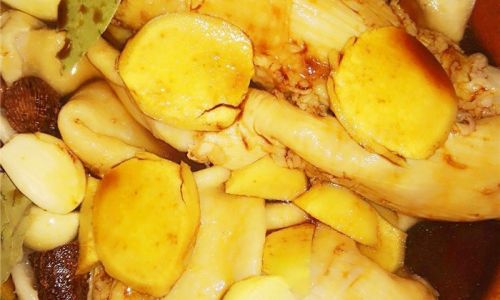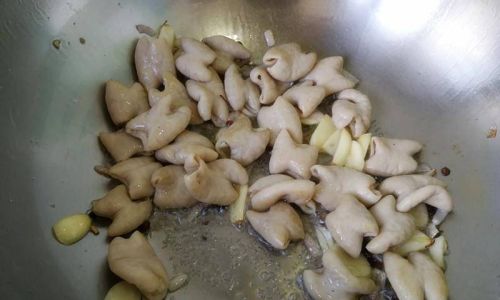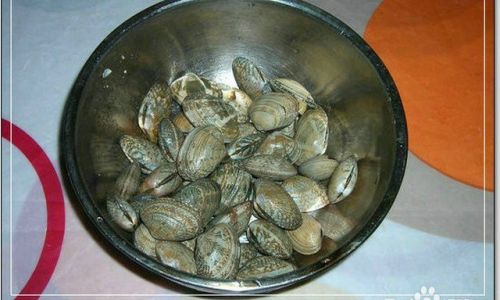Introduction
Stewed large intestine, a dish cherished in many global cuisines, is a testament to the culinary ingenuity of transforming humble ingredients into extraordinary meals. Often overlooked or misunderstood, this organ meat boasts a rich, gelatinous texture and a depth of flavor that, when prepared correctly, rivals even the most prized cuts of meat. From the savory stews of Asia to the hearty braises of Europe, mastering the art of stewing large intestine requires patience, technique, and an understanding of how to balance its unique qualities. This guide will explore every facet of this process, from selecting the finest ingredients to achieving melt-in-your-mouth tenderness, ensuring your dish is both delicious and memorable.
Understanding the Ingredient: The Anatomy of Large Intestine
Before diving into recipes, it’s essential to appreciate the large intestine’s structure and why it demands specific cooking methods. Composed of dense connective tissue, collagen, and a layer of fat, this organ is naturally tough and resilient. However, when subjected to slow, moist heat, the collagen breaks down into gelatin, resulting in a luxuriously tender texture. Unlike lean meats, which dry out during prolonged cooking, the large intestine thrives in stews and braises, where its robustness becomes an asset.
Sourcing and Preparing the Intestine
1 Selecting Fresh, High-Quality Intestines
The foundation of a great stew begins with sourcing fresh, odor-free intestines. Look for specimens with a pinkish hue, minimal discoloration, and a firm, springy texture. Avoid those with a strong ammonia smell, as this indicates spoilage. If possible, purchase from reputable butchers or ethnic markets specializing in offal, as they often handle these cuts with care.
2 Cleaning: The Most Critical Step
Proper cleaning is non-negotiable. Rinse the intestines thoroughly under cold water, using your fingers to gently scrub away any debris. For deeper cleansing, soak them in a solution of vinegar and water (1:4 ratio) for 30 minutes. The acidity helps neutralize odors and loosen impurities. Alternatively, a saltwater soak (½ cup salt per gallon of water) achieves similar results. After soaking, drain and rinse again.
3 Parboiling: The First Step to Tenderness
Parboiling removes residual impurities and begins the tenderizing process. Place the cleaned intestines in a large pot, cover with cold water, and add aromatics like ginger slices, garlic cloves, and a splash of rice wine or vinegar. Bring to a boil, then reduce to a simmer for 15–20 minutes. Skim off any foam that rises to the surface. Drain, rinse under cold water, and pat dry. This step ensures a cleaner flavor and a head start on breaking down tough fibers.

The Science of Slow Cooking: Techniques for Perfect Texture
1 Braising vs. Stewing: What’s the Difference?
While often used interchangeably, braising and stewing differ slightly. Braising involves cooking larger pieces of meat partially submerged in liquid, often in a covered pot, at low temperatures. Stewing uses smaller, uniformly sized pieces fully submerged in liquid. For large intestine, both methods work, but stewing allows for more even cooking and a richer sauce.
2 The Ideal Cooking Liquid
A flavorful liquid is the soul of the stew. Start with a base of broth (chicken, beef, or vegetable) and enhance it with aromatics. Soy sauce, oyster sauce, or fish sauce add umami, while rice wine, sherry, or beer contribute acidity and depth. For a Asian-inspired twist, try a combination of soy sauce, star anise, and cinnamon. In Latin American preparations, tomatoes, chili peppers, and cumin dominate.
3 Temperature and Time: Patience Is Key
Low and slow is the mantra. Maintain a gentle simmer between 180–200°F (82–93°C). Boiling risks toughening the meat, while too low a heat may not activate collagen breakdown. Cooking times vary but typically range from 2.5 to 4 hours, depending on the cut’s thickness. Test for doneness by piercing the meat with a fork—it should glide in effortlessly.
Building Flavor: Aromatics, Spices, and Seasonings
1 The Holy Trinity of Aromatics
Onions, garlic, and ginger form the flavor backbone of many stews. Sauté them in oil until golden to mellow their sharpness and unlock their sweetness. For a richer base, add caramelized onions or roasted garlic.
2 Spices and Herbs: Global Inspirations
- Asian Profile: Star anise, Sichuan peppercorns, cinnamon, and cloves.
- Latin American Profile: Cumin, oregano, smoked paprika, and bay leaves.
- European Profile: Thyme, rosemary, bay leaves, and black peppercorns.
3 Acidity and Sweetness: Balancing Act
A touch of acidity (vinegar, citrus, or tomatoes) brightens the stew, while sweetness (brown sugar, honey, or carrots) rounds out the flavors. Adjust these elements to taste, but err on the side of restraint—overdoing either can unbalance the dish.
Regional Variations: Exploring Global Recipes
1 Chinese-Style Red-Braised Intestines

- Ingredients: Soy sauce, rock sugar, star anise, ginger, garlic, Shaoxing wine.
- Method: Braise intestines in a mixture of soy sauce, water, and aromatics until glossy and tender. Serve with steamed buns or rice.
2 Mexican Menudo
- Ingredients: Dried guajillo chilies, hominy, oregano, cumin, lime.
- Method: Simmer intestines with hominy and a chili-based broth until thick and flavorful. Garnish with cilantro, onion, and lime.
3 Filipino Pancit Palabok
- Ingredients: Shrimp sauce (bagoong), annatto oil, chicharon, hard-boiled eggs.
- Method: Layer stewed intestines over rice noodles with a savory sauce, topped with crispy pork rinds.
Troubleshooting Common Pitfalls
1 Tough or Chewy Texture
- Cause: Insufficient cooking time or high heat.
- Fix: Extend cooking time and ensure a gentle simmer.
2 Bitter or Gamey Flavor
- Cause: Inadequate cleaning or overcooked aromatics.
- Fix: Double-check cleaning steps and avoid burning garlic/onions during sautéing.
3 Greasy Broth
- Cause: Excess fat not trimmed before cooking.
- Fix: Skim fat during cooking or refrigerate the stew overnight to solidify and remove congealed fat.
Pairing and Presentation: Elevating the Dish
1 Complementary Sides
- Rice/Grains: Jasmine rice, quinoa, or crushed corn tortillas.
- Vegetables: Bok choy, spinach, or roasted root vegetables.
- Pickles: Quick-pickled daikon or cucumbers for acidity.
2 Garnishes for Flair
Fresh herbs (cilantro, basil), sliced scallions, toasted sesame seeds, or a drizzle of chili oil add texture and color.

Health Considerations and Nutritional Benefits
While high in cholesterol, large intestine is also rich in collagen, which supports joint health and skin elasticity. Moderation is key, and pairing with fiber-rich vegetables balances the meal. For those with dietary restrictions, leaner cuts or vegetable-based substitutes can mimic texture without the fat.
Storage and Reheating: Making the Most of Leftovers
Stewed intestines improve in flavor after a day or two. Store in airtight containers for up to 4 days, or freeze for 3 months. Reheat gently over low heat, adding a splash of broth or water to prevent drying out.
Conclusion: The Joy of Mastering a Classic Dish
Stewing large intestine is a labor of love, but the rewards are immense. From the satisfaction of transforming a challenging ingredient into a culinary masterpiece to the joy of sharing it with others, this dish embodies the essence of home cooking. Whether you’re exploring traditional recipes or inventing your own, remember that patience, attention to detail, and an open mind are your greatest allies. So, embrace the process, savor the results, and let this humble ingredient surprise and delight your palate.
Epilogue: A Note on Cultural Appreciation
Large intestine dishes hold cultural significance in many societies, often served during festivals or family gatherings. Approach this ingredient with respect for its culinary heritage, and you’ll find not just a meal, but a story waiting to be told.





0 comments